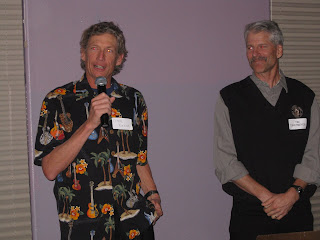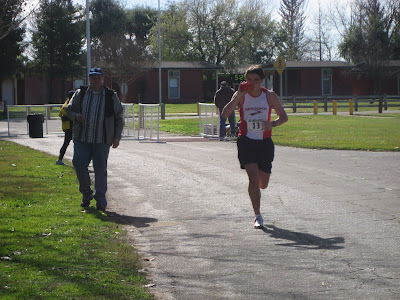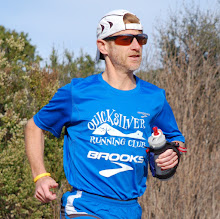LDR stands for Long Distance Running and was the theme of this Saturday Awards Banquet hosted by the Tamalpa Runners in San Rafael. The party was held at The Club, the restaurant of
the McInnis Park Golf Center. I drove up there with Bill Dodson, a club mate from
the Stevens Creek Striders, and his daughter, Estelle. The 120-mile round-trip was a good opportunity to get to know Bill better and discuss our respective plans for the 2009 season. We left South Bay just before dawn. The sky was so clear, we could enjoy views tens miles away from the scenic Highway 280. And thousands of stars on the way back.

Hats down to the Tamalpa Runners for hosting a perfect event, from the very professional setting (audio and video), neat dinner, outstanding guest speakers, a detailed program, special awards, to a thoughtful recognition of the many champions of the 2008 racing season.

The first speaker was Dan Bowden, the first American to break 4 minutes (3:58.7 precisely) on the mile, at Cal (Berkeley) on June 1, 1957 (see
this interesting article and interview of Dan on Recordnet.com by Paula Parrish). We first looked at a USATF video retracing Dan's quest toward this symbolic milestone. Then, in front of a captivated audience, Dan shared many personal notes and memories of the years leading and following this key achievement. Although the theme of the evening was long distance running, we could all very much relate to the feelings expressed by Dan, from the difficulties of training so hard during his College years to the happy moments he shared about his coach, team mates, opponents. In addition to Dan's wife, several others in the audience had followed these events in the fifties as you could see from the nods.

The second illustrious guest speaker was much more from the LDR world with his 25 Western States runs, including 5 overall wins and 15 consecutive top-5 finishes:
Tim Twietmeyer! Although LDR covers short and long distance road races, cross country and ultra trail and mountain running, about half the audience had run at least one ultra, so the ultra was heavily represented and eager to learn from Tim. Tim was interviewed by the local elite trail runner, Greg Nacco. And Greg excelled at the exercise, maximizing the use of his 30-minute slot to get Tim to share a variety of anecdotes and tips, in a Saturday-Night-Show way! I am not going to attempt to give you a full transcript, only a video would convey the liveliness of this interview. However, for those who could not make it, see at the bottom of the post some of the key take-aways from my notes.
After such enlightening presentations, it was time to turn to the less known local champions, the winners of the 2008 Race Season. No less than 76 trophies were awarded, from individual runner, volunteer and team awards, in 4 race categories (short and long road racing, cross country and ultra running), men and women, and up to 6 age groups now that Sam Hirabayashi (Tamalpa) has is own Super Veteran category! Nevertheless, despite this long list of names, our PA USATF LDR committee did a wonderful job at keeping a good pace while providing ample and personal words of recognition to most of us.
On the Road Racing and Cross Country side, the ones whom I found the most impressive among the awardees in the audience were:
- Brian Pilcher, from Tamalpa, National Senior (50+) Cross-Country champion;
- Russ Kiernan, also from Tamalpa, who won three out of three catageroy awards!
- Bill Dunn, from West Valley Joggers and Striders, who brought home 4 individual awards and 3 for his club!
Bill was at our table and, before leaving, told Bill (Dodson) and I he was one of the co-founders of our club,
the Striders, in the early 80s.
On the Ultra Running side, here are 5 of the 6 age group champions, from left to right: Bill Dodson (Stevens Creek Striders, Veteran, 70 and above), Joseph Swenson (unattached, Senior, 50+), Jean Pommier (yes, I, Stevens Creek Striders, Masters), Eduardo Varquez (Pamakids, Senior Open) and Jason Reed (NB Excelsior, Open), and in the background on the far left, Ken Grebenstein, the President of
the Tamalpa Runners, the hosting club:

Last year, in addition to winning my age group, I was awarded the coveted title of "Pacific Association Ultra Runner of the Year", for my first year in ultra and my focus on the PA MUT Grand Prix. I was proud to be nominee again this year but glad that Eric Skaden got the award this year, much deserved on the basis of the very impressive achievements at Tahoe Rim Trail 100-mile (overall win), Miwok and American River. Incidentally, Eric took first in last year's Montrail Cup and I took second.
Bev (Anderson-Abbs) took home the PA Ultra Runner of the Year too. Here she is with her husband, Alan (right) and our dear and dedicated LDR MUT Commissionner, Hollis Lenderking.

The second pillar of our MUT Grand Prix, Gary Wang (Tamalpa), and no less dedicated volunteer, received the 2008 Service Award for Ultra Running. He was all smile:

Again, congratulations to the Tamalpa Runners for a perfectly run event, and great awards! THANK YOU, and see you on the trails for some sane competition!

A summary and brief transcript of Tim Twietmeyer's interview by Greg Nacco. (I've inserted a few pictures of Western States at Last Chance, from the times I was the Captain of this aid station, on behalf of
the Sriders who have been manning it for 27 years in a row!)

Greg kicked off the interview by counting one of his run of the 80s, SilverState, during which Tim saved him by lending him his gloves while they were running through the blizzard.
 Greg: When and how did you get into running?
Greg: When and how did you get into running?Tim: In high school I was playing competitive golf, when the youngest of my three oldest sisters started running. I felt I had to do to and started running too. I lived in Woodside then and, during my Junior and Senior years, I found out about a 24-hr event at Woodside School Track (read about it on the back cover of Runner's World at the library). Was amazed to see runners like
Dick Collins,
Ruth Anderson, Big John, Don Choi (
the pionneer of the modern 6-day races), running laps and putting in more than 100 miles. Then I heard about Western States, applied, ran my first 50-miler at this track event in 1979, went on the course and, after seeing the canyons, decided WSER wasn't for me, yet.
Greg: When did you run your first 100-miler then?Tim: One year later, in 1980, I went back to the Woodside track and ran 100 miles in 21 hours and change.
Greg: We heard about Dan on the mile, what about you on shorter distances?Tim: I'm not that fast (laugh)! My PRs are about 17:30 on 5K, around 37' on 10K, 2:36 and change on marathon. And for the mile? Never ran under 5'.
From the audience: What were your first times at Western States?Tim: 22:04 the first year and 22:53 the second. Felt great the first year, miserable the second. I got sick and, as I was recovering toward the end of the race, it was the turn for my dad who was pacing me. It ended up to be a miserable experience for both of us!
Greg: Speaking of pacer, ever dropped one in a race?Tim: Well, yes... twice actually. The first time was at WS in 1985. A tough one, a snow year (snow on the first 20 miles) yet with high temperatures in the 105-106F. I was in the lead at the river with 20 miles to go when I heard people cheering a runner on my heels. That was Ann Trason, in second. My pacer wasn't going well, as opposed to Ann's pacer, Frank Ruona (author's note: who just happened to be sitting next to me at dinner!).
Greg: Can you think of a perfect race?Tim: I would elect the year I broke the Masters course record. In retrospect, you always wonder, after a race, what you could have done differently. On this one, I could not find anything. I remember having taken salt at the right time, before getting potentially dehydrated.
Greg: You've proven yourself on Western States, what's your next challenge?Tim: yes, I'm semi-retired from Western States (author's note: does the semi imply a come back à la Lance Armstrong on Tour de France, or Scott Jurek at WSER next June?? A come back to set the 50-59 course record?). When you are in your mid-forties, you realize that you are not getting faster. I'm thinking of some adventure racing, or runs in stages, from one point to another. I've been pretty much focusing on Western States for 25 years, so I would also like to try new events.
Tim enjoying Dick's "car wash" at Last Chance, WS '06 (with Tom Kaisersatt in the background):
 Greg: Favorite training run?
Greg: Favorite training run?Tim: yes, a very specific one: go on the Western States course, start from mile 70 back to mile 45 (Swinging Bridge). Take a swim, then come back. Stop at Foresthill (mile 62) and enjoy an ice cream sandwich and mountain view, then hammer down the last 8 miles. We call this run the "ice cream sandwich run!" Leaving Foresthill strong is what separates the top runners from the rest.
Greg: Any tip about pacers and crew?Tim: The best is to have folks entertaining, positive, making good jokes. When you are on the trails for a day, and you know that it's going to be a couple of hours before you see your crew again, you need people you can rely on to get re-energized very quickly at aid stations. It's like plugging in to get your battery recharged and pulling the plug until the next stop. Your crew has to know you well, what you eat and drink in races.
Greg: You are known for wearing headphones, what are you listening to?Tim: it varies from rather cool music (country) early in the race, to hard rock such as AC/DC toward the end!
Greg: Tips on fueling during a 100-miler?Tim: clearly, the most important idea to keep in mind is that, the more you go, the less you can eat. So you have to take a lot of calories in the first part, which you will use in the second half. At the end, it's a lot about sugar and caffeine, M&M's, soup.
At Last Chance, WS '05, photo courtesy of Kiran:
 Greg: You are a big sport fan, what is your favorite team?
Greg: You are a big sport fan, what is your favorite team?Tim: These days, my top of the list team is the San Jose Sharks. I love watching hockey. Amazing how every team member is playing, in a constant rotation or shift between the bench and the ice.
Greg: Do you practice another sport?Tim: I tend to do more cycling now, which provides great cross-training while reducing the impact. I was telling Gary that, eventually, I will go back to swimming at some point, making the full circle, closing the loop.
From the audience: How are your knees?Tim: so far so good! And cycling for cross-training helps.
Greg: Who are you rooting for in the Super Bowl?Tim: St Louis! I mean Arizona, they have a good chance to win this year.
Greg: How do you balance work, family and running?Tim: This is really something I don't know much about. I have always been running a lot, at least one hour a day, most of the days since high school, so it has always been part of my adult life, and part of our family life.
From the audience: Did you run into snakes?Tim: Spending thousands of hours on the trails out there, I certainly saw bears and snakes, but never a mountain lion. Snakes are particularly dangerous as they emerge at the first hot days in the season, and they are really hungry, loaded with venom...
From the audience: What about tips on the mental side?Tim: Indeed, mental is essential to do well in competitive running. I started realizing it when I had a disappointing 50K road race after the birth of our second child (who had some handicap). I knew I could have done much better, but I had thousands of thoughts juggling in my mind. After that, I started doing much more analysis of races, like chopping the Western States course in small pieces, knowing them perfectly to the point that I could visualize how I will be on each of them on race day. To the point I was right on where I wanted to be on race day. (Author's note: similarly to Dan's remark, that he knew to the tenth of second his split without having to look at a stop watch.)
Tim looking strong as he is leaving Last Chance (mile 43) at WS '06:
 Greg: Any last tip to conclude?
Greg: Any last tip to conclude?Tim: Yes, to do well at Western States, you have to hammer down the downhills. These are sections were you don't use much energy and the downhills is what makes a big difference among the top runners on this course. You need to push as much as running them at your half-marathon pace.
Way Too Cool start, March 2007:











.jpg)






















.jpg )
